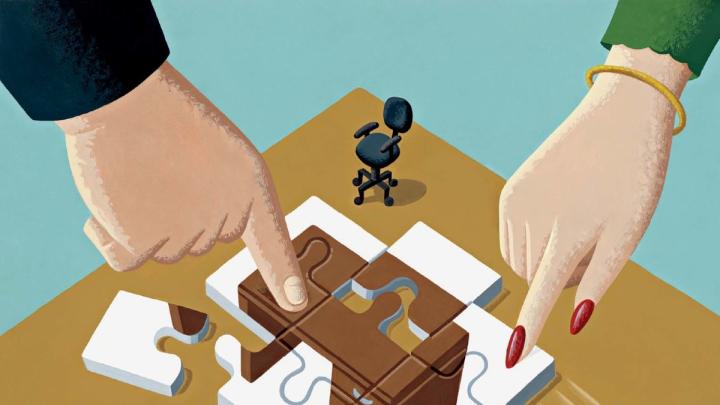It’s deceptively easy to calculate how much—or how little—women in the United States earn relative to men. “You take everyone who’s working 35 or more hours a week for the full year, find the median for women, find the median for men, and divide,” says Lee professor of economics Claudia Goldin, explaining how to arrive at the ratio repeated by public officials: 78 cents to the dollar. “It’s very simple.”
“It answers a particular question,” she says, “but it doesn’t say that men and women are doing the same thing. It doesn’t say that they’re working the same amount of time, the same hours during the day, or the same days of the week.” The rhetoric of politicians, and policy prescriptions meant to close the gender wage gap, assume that pay disparities are created primarily by outright discrimination by employers, or by women’s lack of negotiation skills. Goldin has a less popular idea: that the pay gap arises not because men and women are paid differently for the same work, but because the labor market incentivizes them to work differently.
Consider a couple graduating together from a prestigious law school, and taking highly paid jobs at firms that demand long hours. The evidence suggests they’re likely to begin at similar salaries. But a few years later, Goldin says, one of them—more likely the woman—may decide to leave for a smaller practice with fewer hours and more flexibility in scheduling. In that new job, research suggests, she’s likely to earn less per hour than her partner. Goldin calls this phenomenon non-linearity, or a part-time penalty: the part-timer works half the time her partner does, but earns less than half his salary.
It isn’t clear, she says, why firms compensate on a non-linear scale in the first place. “Why would anyone pay for that?” she asks. Apart from scenarios in which a client might want a lawyer available at all hours, day or night—during a merger or acquisition, say—and must offer a hefty premium for that unrestricted access, she says, “It’s a question I don’t have a particularly good answer to.”
Non-linear compensation prevails in the corporate sector, finance, and law, where employees are incentivized to work double or triple a traditional full-time schedule, because their time is better compensated per hour when they work longer hours. That compensation structure makes it more lucrative for one partner to work 80 hours and the other not to work at all than for both of them to work 40 hours each. If both partners opt for 40-hour weeks so they can share responsibilities at home, Goldin says, “lots of money is going to be left on the table,” which is why she believes so many couples don’t.
Non-linearity helps explain why most of the gender pay gap occurs within professions, Goldin adds. The distribution of men and women in different occupations accounts for only 15 percent of the gap, and the remaining 85 percent arises within occupations. (For college graduates, those numbers are 35 percent and 65 percent, respectively.) In science and health professions, though, workers are more likely to be compensated at a constant rate for additional time worked, and the ratio of women’s earnings to men’s is higher—about .892. For occupations in business and finance, the ratio is .787, and for lawyers, .815, closer to the national gender wage gap.
Improvements in technology have made it easier for some health and science professions to substitute workers for one another in a single job, which reduces the cost to companies of offering a flexible-hours option to employees. Goldin calls pharmacy “the most egalitarian profession” because it shows nearly perfectly linear compensation and one of the smallest gender pay gaps of any field. “Pharmacy has no part-time penalty,” she says. Structural changes, such as centralized computer records and standardization of drugs, allow one pharmacist to take over easily for another without compromising the quality of work. And because it’s easy for pharmacists to work part-time, women are less likely to have to leave their jobs to care for their families, a decision that can make it difficult to reenter the workforce later.
Goldin believes other fields could narrow their gender wage gaps, too, if they did not have an incentive to pay workers disproportionately more for working more. How to induce change in the labor market isn’t obvious. Why can’t you convince clients, she asks, that your employees are like puzzle pieces, each knowing everything the others know, so they’re good substitutes for each other? “As their labor costs mount,” she suggests, firms “will figure out how to make workers better substitutes for each other,” Technological change might also play a role, doing for law, perhaps, what it’s done for health professions, and making it easier for lawyers to hand off clients to one another. But in some cases, Goldin concedes, it may not be possible to embrace this modular model: “We don’t want the president of the United States to be a part-time president.”
As for policy interventions to close the gender earnings gap—a California law makes it illegal to retaliate against employees for sharing information about their pay, for example—“That’s probably a good thing,” Goldin says. “If the fruit is low-hanging, by all means pick it.” But she balks at the suggestion that regulation can fix what she sees as a labor-demand problem. Creating an egalitarian workplace, she believes, will depend primarily on reducing the cost of offering time flexibility to workers—securing equal pay for equal work, in the strictest sense.







